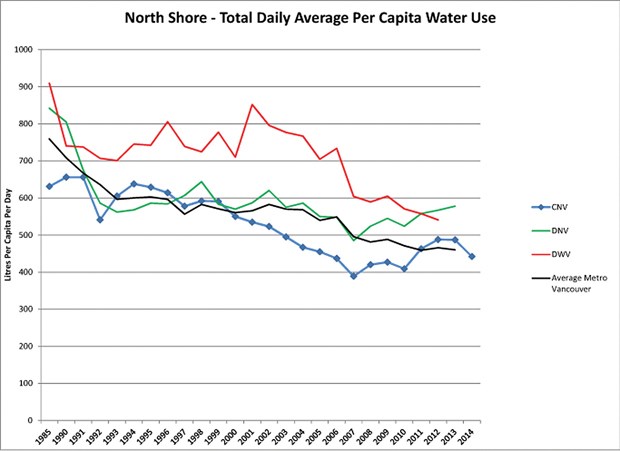Two faulty water meters are to blame behind recent Metro Vancouver data that appeared to show both the City and District of North Vancouver’s water consumption has risen in the past decade.
But that’s not true, said water managers in both North Vancouver municipalities this week.
“We’re not water hogs,” said Shaun Carroll, manager of utilities for the District of North Vancouver. In fact, when it comes to residential water use, she said, the municipality’s own information puts the amount of water used at about 300 litres per person per day on average — around the national average.
The problem for both communities is that faulty water meters feeding into the city and district were under-reporting the total amount of water used from about 2003 to 2010. That made it look like water use increased after 2011. But actually it didn’t.
Following a July 17 article in The Vancouver Sun that stated the City of North Vancouver saw a 16.6 per cent increase in total water consumption between 2004 and 2013, city staff were asked to prepare a report on the issue.
The conclusion, presented at Monday’s council meeting, is that for a period of time when the data was collected, the city’s most significantly used water meter — near Lynn Valley Road and Sutherland Avenue — was undercounting the amount of water passing through it. Staff reported the malfunction early on to Metro Vancouver, which controls this meter, when they first noticed the drop in volume in 2003.
However, the meter replacement was put on Metro’s capital fund and wasn’t completed until late 2010, according to city staff. It was only after the meter was replaced that data began to show a “rise” in water consumption for the city, which Douglas Pope, city engineer, attributed to the meter once again correctly accounting for water use.
A nearly identical scenario happened in the district, where a meter near Riverside Drive under-reported water use for a similar period of time.
Pope said that after factoring out the malfunction in that particular meter, which serves a large portion of the city, water use per capita in the city is actually slightly below the regional average.
“Our information shows the city’s current total per capita water use is a little below the Metro average and if we separate out industrial, commercial and institutional use, we are well below many other municipalities in the region,” he said, citing data graphs that compare the city to other Metro municipalities.
Forty-five per cent of water use in the city goes to industrial or commercial users, according to Pope. That’s a similar situation to the District of North Vancouver, where the top 10 industrial users accounted for 25 per cent of the municipality’s annual water use.
“Really if you counter that metering issue, what really occurred was that our total consumption only increased slightly even though our population was increasing…” said Pope.
City council welcomed a chance to set the record straight at Monday’s regular meeting of council, especially in light of water conservation efforts it has implemented in recent years.
“My concern was simply that we were painted badly, I think, in a front-page story and I’m glad that we had an opportunity to clarify here,” said Coun. Don Bell, who introduced the motion for a report following last week’s article.
Bell also questioned whether leakage from the city’s water pipes might have been a contributing factor. Pope responded by saying, “Like all Metro municipalities we experience leaks in our system. We deal with them as quickly as we come across them but every water system has leaks.”
Pope added the city is looking at getting improved leak detection equipment.
Coun. Linda Buchanan expressed the importance of getting the correct information out as soon as possible. “Poor data leads to poor conclusions,” she said.



